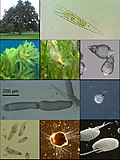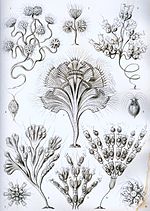The Rhizaria are a diverse and species-rich supergroup of mostly unicellular eukaryotes. Except for the Chlorarachniophytes and three species in the genus...
17 KB (1,548 words) - 09:22, 26 August 2024
Heliomonadida/Dimorphida and Gymnosphaerida (currently in Rhizaria > Cercozoa) Taxopodida/Sticholonche (currently in Rhizaria > Radiolaria) Rotosphaerida (currently in...
6 KB (505 words) - 15:56, 18 August 2024
secondary endosymbiosis of red algae through a common ancestor. Meanwhile, Rhizaria was traditionally considered to be a separate supergroup. More recent phylogenetic...
11 KB (1,083 words) - 02:19, 13 September 2024
"Five new species and two new genera of xenophyophores (Foraminifera: Rhizaria) from part of the abyssal equatorial Pacific licensed for polymetallic...
35 KB (3,884 words) - 19:56, 26 August 2024
inclusive clade containing Bigelowiella natans Moestrup & Sengco 2001 (Rhizaria), Tetrahymena thermophila Nanney & McCoy 1976 (Alveolata), Thalassiosira...
8 KB (739 words) - 03:55, 2 October 2024
Proterozoic Archean Had. Cryptista Viridiplantae (plants) Discoba Amoebozoa Rhizaria Alveolata Animalia Fungi Scientific classification Domain: Eukaryota (Chatton...
61 KB (6,130 words) - 18:03, 20 September 2024
Retaria (category Rhizaria taxa)
within the supergroup Rhizaria containing the Foraminifera and the Radiolaria. In 2019, the Retaria were recognized as a basal Rhizaria group, as sister of...
3 KB (146 words) - 18:11, 15 April 2024
some animal cells: in part of Filosa (Rhizaria), in "Testaceafilosia", in Vampyrellidae and Pseudosporida (Rhizaria) and in Nucleariida (Opisthokonta)....
16 KB (1,747 words) - 18:27, 11 March 2024
well-studied group of mostly free-living heterotrophs known as ciliates. Rhizaria is a morphologically diverse lineage mostly comprising heterotrophic amoebae...
94 KB (9,770 words) - 10:59, 30 September 2024
that usually have complex shells, and together form a supergroup called Rhizaria. The group includes most amoeboids and flagellates that feed by means of...
20 KB (1,884 words) - 11:15, 24 April 2024
Largest organisms (section Rhizarians (Rhizaria))
This article lists the largest organisms for various types of life and mostly considers extant species, which found on Earth can be determined according...
22 KB (3,091 words) - 22:17, 17 August 2024
the three major clades in the SAR supergroup, along with Alveolata and Rhizaria. Stramenopiles are eukaryotes; most are single-celled, but some are multicellular...
33 KB (3,303 words) - 12:05, 31 August 2024
Rhizaria into the Cabozoa and the Archaeplastida and Chromalveolata into the Corticata, but at least one other study has suggested that the Rhizaria and...
9 KB (705 words) - 15:06, 2 September 2024
xanthophytes, eustigmatophytes Alveolata: some apicomplexans (gametes) Rhizaria: some radiolarians (probably gametes), foraminiferans (as gametes) Cercozoa:...
13 KB (1,350 words) - 03:43, 17 June 2024
Bacteria Eukaryota (major groups Excavata Diaphoretickes Hacrobia Cryptista Rhizaria Alveolata Stramenopiles Plants Amorphea Amoebozoa Opisthokonta Animals...
127 KB (11,387 words) - 15:45, 28 September 2024
Protozoan infection (section Rhizaria)
[citation needed] The supergroup SAR includes Stramenopiles, Alveolata and Rhizaria, and is distinguished by fine pseudopodia which can be branched, simple...
32 KB (3,716 words) - 02:51, 17 September 2024
Bacteria Eukaryota (major groups Excavata Diaphoretickes Hacrobia Cryptista Rhizaria Alveolata Stramenopiles Plants Amorphea Amoebozoa Opisthokonta Animals...
24 KB (2,050 words) - 19:56, 12 September 2024
supergroup (named for the included groups Stramenopiles, Alveolata and Rhizaria) and Hacrobia (Haptista and Cryptista). Patron et al. (2004) considered...
26 KB (2,441 words) - 20:55, 15 May 2024
Alternation of generations (section Rhizaria)
Double fertilization Some organisms currently classified in the clade Rhizaria and thus not plants in the sense used here, exhibit alternation of generations...
40 KB (4,576 words) - 05:27, 4 May 2024
paraphyletic group, the chromalveolates. The two clades together with the Rhizaria (originally one of the six major eukaryote groups) form a clade dubbed...
5 KB (380 words) - 18:16, 15 April 2024
traditional sarcodines are placed in two eukaryote supergroups: Amoebozoa and Rhizaria. The rest have been distributed among the excavates, opisthokonts, and...
41 KB (3,651 words) - 21:00, 29 September 2024
the Protozoa known as the Rhizaria. Prior to the recognition of evolutionary relationships among the members of the Rhizaria, the Foraminifera were generally...
86 KB (8,497 words) - 12:47, 17 June 2024
within Eukarya. They are currently grouped with the stramenopiles and Rhizaria among the protists with tubulocristate mitochondria into the SAR supergroup...
26 KB (2,694 words) - 23:49, 15 June 2024
Nassellaria is an order of Rhizaria belonging to the class Radiolaria. The organisms of this order are characterized by a skeleton cross link with a cone...
11 KB (1,154 words) - 21:34, 18 July 2024
agreement that the Rhizaria belong with the Stramenopiles and the Alveolata, in a clade dubbed the SAR supergroup, so that Rhizaria is not one of the main...
74 KB (4,819 words) - 04:50, 25 September 2024
taxonomic groups, such as the Chromista, Chromalveolata, Opisthokonta, Rhizaria, and Excavata. He was known for his systems of classification of all organisms...
26 KB (2,692 words) - 18:01, 8 April 2024
former cnidosporans, are also sometimes called plasmodia. Similarly, in Rhizaria, the amoeboid, multinucleate protoplasts of some Cercozoan algae, e.g....
3 KB (314 words) - 04:41, 28 January 2021
Bacteria Eukaryota (major groups Excavata Diaphoretickes Hacrobia Cryptista Rhizaria Alveolata Stramenopiles Plants Amorphea Amoebozoa Opisthokonta Animals...
50 KB (5,817 words) - 02:28, 14 September 2024
polyphyletic assemblage of unrelated eukaryotic organisms in the Stramenopiles, Rhizaria, Discoba, Amoebozoa and Holomycota clades. Most are microscopic; those...
54 KB (5,528 words) - 18:53, 22 September 2024
Circogonia icosahedra pictured below. The radiolarians belong to the supergroup Rhizaria together with (amoeboid or flagellate) Cercozoa and (shelled amoeboid)...
28 KB (2,561 words) - 18:37, 13 September 2024




























